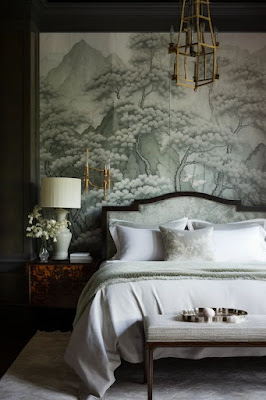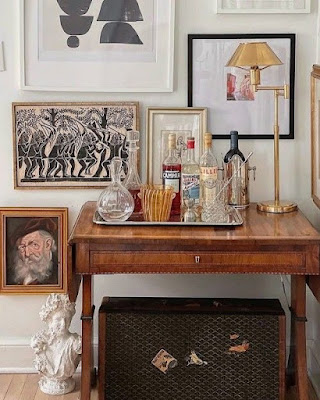I call it the naked console when the floor space beneath a console is left undone. I am not a fan of design clutter, but I am also not a fan of a blank canvas. The most forgotten areas of a design plan are the final layering in of finishing touches and ceilings. This is where the naked console happens. We'll talk about forgotten ceilings in a future post.
If a console with an open base, even if there is a stretcher, has been chosen for your design plan avoid the naked console by not only considering the design elements that are going to be showcased on the top of the console but what will be layered in below the console. It is like a perfect wine pairing - contemplate the wine notes and how they will affect the taste of its food counterpart.
Take heart in that the solution to the naked console problem can happen as soon as you are aware the problem exists. Approach this solution just like you would any other by giving it thoughtful respect. It is not something to rush into unless you get that aha moment of clarity that finally, you have found those design elements a place you to reside.
A well-designed naked console takes a lesson in the art of pondering. The art of pondering is a place where silence, daydreaming and wonderment are welcome and necessary. If you've been around any good designer, you have seen the art of pondering. It can be reflected by their stare is either on the table that holds a project's design elements and inspiration or on a single spot on the wall as they mentally envision. Their posture is a bit relaxed as they practice the art of pondering.
Our home is too important to allow undone. Haphazard is not part of your home's completion. There will be naked consoles and other blank areas that are pending. Just have a plan in place and keep these areas on your design to-do checklist. The plan doesn't need to be finalized it just needs to be a plan to complete and we need to be playing around with options we own or sketching out what we thoughtfully ponder as possibilities.
Design is joy! Remember that. It is learning and choosing what helps us live a life surrounded by design elements that comfort us. It's our Calgon.
“Don't Just"
Don't just learn, experience.
Don't just read, absorb.
Don't just change, transform.
Don't just relate, advocate.
Don't just promise, prove.
Don't just criticize, encourage.
Don't just think, ponder.
Don't just take, give.
Don't just see, feel.
Don’t just dream, do.
Don't just hear, listen.
Don't just talk, act.
Don't just tell, show.
Don't just exist, live.”
― Roy T. Bennett, The Light in the Heart
The naked console with its unwritten space underneath is your design biography - it can be a short, simple yet profound story or it can be a story full of illustration. Sketch out your draft, ponder it and then layer in the final vignette. Juxtaposition will become a design triumph. Yes, the design elements can be functional but think beyond that. Think opposites attract. Think contrast.
Ponder a simpler console surface and clean wall backdrop to reserve the drama for the floor area under the console. Throw caution to the wind and display your collection of busts or blue and white Chinoiserie under the console instead of on the console. Prop the cherished small but mighty painting on the floor under the console rather than hanging it over the console. Ponder, and then ponder again.
A well-chosen basket under a console is fine. Anyone can do fine. Ponder the shape of the baskets, who was the artist whose hands wove the basket? Are the baskets placeholders until your find the right design elements? Remember temporary still needs to be beautiful and be meaningful. Don't opt for ordinary. If it isn't either beautiful or meaningful opt to leave the canvas blank.
Proportion, scale, and harmony are design principles that are vital to the naked console dilemma. Remember it's a pairing. Shoes make the outfit. (Don't take that literally - don't use the naked console floor area as a mudroom to toss your shoes!)


We are rule breakers first so room designation has nothing to do with this naked console discussion. A piece of furniture has no limitations in our home. Where you place your console has no concern over how you layer it and treat the blank floor area below it. A console is such a versatile and wonderful piece that can be placed anywhere in a design plan. Floating, dividing a room, greeting at an entrance wall, in the kitchen holding prized culinary books and the same accessory consideration you'd give it in any other room, at the end of the bed, in the bath. Length, shape, mixed media, embellishment, style, vibe - all factors in selecting the right piece. So that all seems a tad overwhelming but it's not. Just ask yourself why you are drawn to a piece. If you don't know look again until you can answer that question. Find joy in your selections, every one of them.


What a delight it can be after pondering the naked console to find out that you can look for design elements that otherwise may seem too oversized on top surfaces. You have approximately 26-30 inches of height and a horizontal landscape of space that varies depending on the length of the console to design. The depth of the console is a small factor. There is no rule that says what you layer in under your console is limited to the depth of the space - if it doesn't impede on traffic flow and your shins don't curse you color outside the lines.


I always write and speak about thoughtful design and in this post touch on the art of pondering a design plan. And I am intrigued with the art of hygge the Danish and Norwegian concept that encompasses the feeling of quiet comfort. And I love the Japanese philosophy of wabi-sabi, the perfection of imperfection. These are all great concepts to apply to designing well. And the Brits have a space in their home they refer to as the snug. This is traditionally known in America as a nook, but I love the reference to snug so much better.
Recently I was introduced to the principles of Japanese ikebana by Vicente Wolf who almost always follows these principles when he is composing a setting. In ikebana, the Japanese art of flower arranging, blossoms, branches, leaves, and stems find new life as materials for artmaking. In contrast to the western habits of casually placing flowers in a vase, ikebana aims to bring out the inner qualities of flowers and other live materials and express emotion. Wolf applies this to a setting typically in a three-part structure that represents the heavens (tallest component), humans (medium component), and the earth (smallest component).
These two paragraphs are a long definition for thoughtful and meaningful design but there is no other way to explain it in the context of the reverence it deserves.



Travel to a place, wherever it may be, that allows you to shut out the things like design rules, design trends that are not your aesthetic, shiplap, color of the year, traditional, transitional, modern. Now with a clear mind start dreaming and pondering what you have seen and felt that brings you joy and translate that into your design plan. It's a mood, a vibe, that's your home. Journal all these things, sketch these things, photograph these things. Congratulations you have just started your design file.



The art of pondering will catch you having read this post looking at consoles differently. You will hear how that empty space under the console, the naked console cries out for its moment. Your design file and journal will become simply extraordinary filled with hygge, wabi-sabi, ikebana, and the importance of snug. A blank canvas will become your thorn. You'll want to transform, feel, act, and live your design plan in a new way. This is the fun of design. Dance it out, you've found the joy of design.
Be inspired to become familiar with blank canvases like the naked console. The concept of layering will be like pulling on that favorite sweater. Hello friend I'm here to take your hand and finish your design plan for this home.
Sources (in no particular order): 1st Dibs, Glass of Bovino, Architectural Digest, Arteriors, Atlanta Home, Decor Pad, Habitually Chic, House and Home Magazine, House Beautiful, Instagram, Materia Designs, New York Social Diary, Pinterest, Tumblr, Simple Details, Nathan Turner










































































